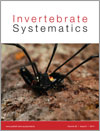The scorpion genus Alacran Francke, 1982, endemic to eastern Mexico, was created to accommodate Alacran tartarus Francke, 1982. This remarkable troglobiotic species is adapted for life in some of the world’s deepest caves, 720–916 m below the surface in the Sistema Huautla of the state of Oaxaca (the deepest records at which a scorpion has been found). A second species, Alacran chamuco Francke, 2009, was later described from Te Cimutaá, also in Oaxaca. In the present contribution, we describe a third species, Alacran triquimera, sp. nov., recently discovered in a cave system in the state of Puebla, and test the monophyly and internal relationships of Alacran, based on a cladistic analysis of 10 terminal taxa (including seven species representing all four genera of Typhlochactidae) and 151 informative morphological characters, building on a previously published matrix. The single most parsimonious tree obtained, supports the monophyly of Alacran and the following relationships among its component species: (A. chamuco (A. tartarus A. triquimera, sp. nov.)). The phylogenetic relationships among the three species of Alacran are consistent with the biogeographical history of the caves they inhabit. Based on the geological history of the Sierra Madre del Sur and the likely similar speleogenesis of the Tres Quimeras, Sistema Huautla and Te Cimutaá caves, we propose a vicariance hypothesis to account for the disjunct distribution of the three species of Alacran, whereby an initially more widespread, panmictic ancestral population speciated into three geographically isolated taxa following fragmentation of the southern Sierra Madre del Sur.
How to translate text using browser tools
19 December 2014
Shining a light into the world’s deepest caves: phylogenetic systematics of the troglobiotic scorpion genus Alacran Francke, 1982 (Typhlochactidae : Alacraninae)
Carlos E. Santibáñez-López,
Oscar F. Francke,
L. Prendini
ACCESS THE FULL ARTICLE
<
Previous Article
|

Invertebrate Systematics
Vol. 28 • No. 6
December 2014
Vol. 28 • No. 6
December 2014
Arachnida
biogeography
caves
Chelicerata
phylogeny
troglomorphism




